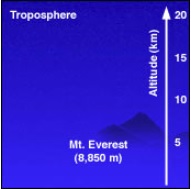Ten to fifteen kilometers above the horizon lies a scientific frontier where chemistry, dynamics and energy balance are the unsettled territories. Beyond the reach of balloons and most aircraft, the upper atmosphere's role in Earth's climate remains to be determined.
Studies of the upper atmosphere are further complicated by the possibility of man-induced change to these outer reaches. For instance, Mark Schoeberl, senior scientist for atmospheric sciences at NASA's Goddard Space Flight Center, and colleagues assessed the environmental impact that may result from a fleet of supersonic aircraft planned to fly in the stratosphere. The flights could cause a one or two percent loss of stratospheric ozone, he said.
According to Schoeberl, most of the supersonic aircraft will fly in the mid-latitudes, releasing water vapor and nitric oxide with engine exhaust. Both substances impact the level of upper atmospheric ozone. Nitric oxide is a powerful destroyer of ozone; water vapor can indirectly destroy ozone through formation of polar stratospheric clouds, thought to be responsible for the large polar ozone depletions seen in the last two decades.
The research team examined Upper Atmosphere Research Satellite (UARS) data from NASA's Goddard Earth Sciences Data and Information Services Center (GES DISC) to see how isolated the tropics are from the mid-latitudes. "This question is important because aircraft exhaust emitted at mid-latitudes in the stratosphere can get into the tropical-latitude stratospheric air, where it can be lofted to very high altitudes and cause ozone depletion," Schoeberl says.
Every 26 months, east-west winds switch direction in the tropical stratosphere, Schoeberl says. The oscillation creates a change in the signature of trace gases because the concentration of trace gases changes with the change in wind direction.
"I was able to use the UARS measurements to look at whether the change in trace gas fields was consistent with wind changes in the quasi-biennial (occurring roughly every two years) oscillation," Schoeberl says.
Schoeberl studied nitrous oxide and methane trace gases data from two instruments mounted on the UARS, the High Resolution Doppler Imager (HRDI) for winds and the Cryogenic Limb Array Spectrometer (CLAES).
"If the winds and the tracers were in good synchronization, I could say that the effects of mid-latitude air mixing into the tropics and diluting the gases was weak," Schoeberl says, calculating that the amount of time necessary for air sample exchange at varying heights to be 18 months or longer.
"A number of other researchers using different observations came up with the same estimate, so it seems to be a robust result, indicating that aircraft exhaust emitted in mid-latitudes slowly reaches the tropical regions," Schoeberl says.
"We are now in the process of comparing model simulations of aircraft exhaust dispersal with this observational result. Right now it looks like the models generate too much exchange which would increase the predicted lifetime of the exhaust products in the stratosphere." Using this result NASA scientists hope to improve the aircraft exhaust models and thus provide a more realistic simulation of the environmental effects of aircraft exhaust.
References
Siskind, D. E., J. T. Bacmeister, M. E. Summers, and J. M. Russel III. 1997. Two-dimensional model calculations of nitric oxide transport in the middle atmosphere and comparison with Halogen Occultation Experiment data. Journal of Geophysical Research 102: 3527-3545.
Summers, M. E., D. E. Siskind, J. T. Bacmeister, R. R. Conway, S. Zasadil, and D. F. Strobel. 1997. Seasonal variation of middle atmospheric CH4 and H20 with a new chemical-dynamical model. Journal of Geophysical Research 102: 3503-3526.
Huang, F. T., C. A. Reber, and J. Austin. 1997. Ozone diurnal variations observed by UARS and their model simulation. Journal of Geophysical Research 102: 12,971-12,985.
Schoeberl, M. R., A. E. Roche, J. M. Russel III, D. Ortland, P. B. Hayes, and J. W. Waters. 1997. An estimation of the dynamical isolation of the tropical lower stratosphere using UARS wind and trace gas observations of the quasi-biennial oscillation. Geophysical Research Letters 24: 53-56.
For more information
NASA Goddard Earth Sciences Data and Information Services Center (GES DISC)
Upper Atmosphere Research Satellite (UARS)
| About the remote sensing data used | ||
|---|---|---|
| Sensor | Upper Atmosphere Research Satellite (UARS) | |
| Parameter | upper atmosphere | |
| DAAC | NASA Goddard Earth Sciences Data and Information Services Center (GES DISC) | |

